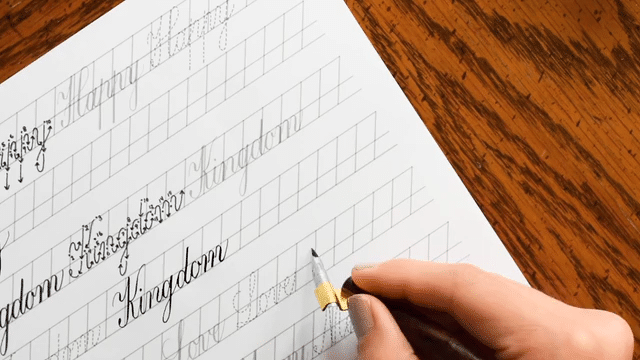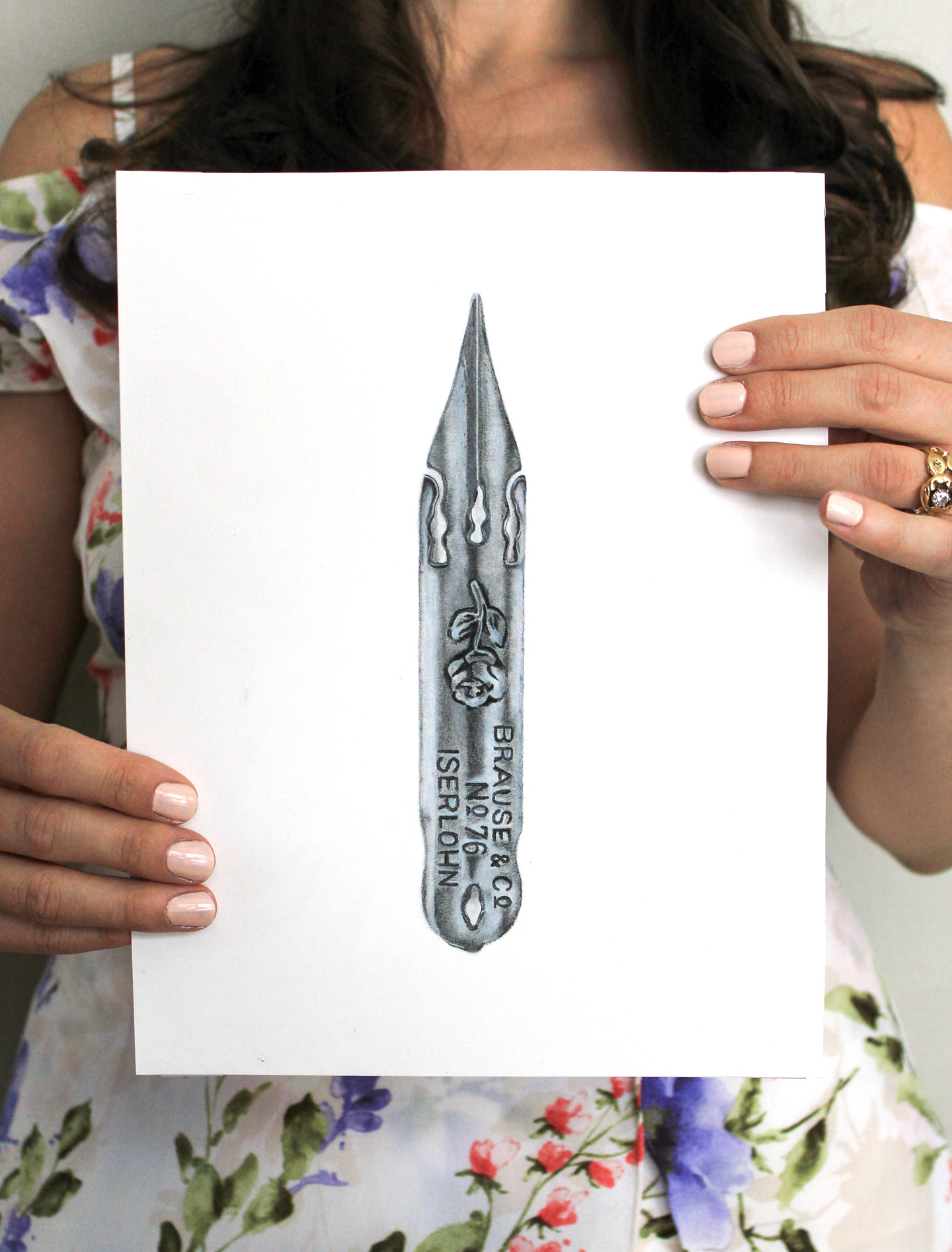
When I first began learning how to use a dip pen, calligraphy nibs were a mystery to me. I remember being very confused about which nib to use, how to use it, and what to do with it when I wasn’t using it! If you have the same questions, this post will be helpful.
1. Remove the Manufacturer’s Oils from New Calligraphy Nibs
Calligraphy nib manufacturers put oily substances on nibs to ensure that the nibs stay nice in pre-sale storage. When you try to use a new nib, however, you will find that the oily nibs and ink don’t mix! That can cause ink flow issues that are particularly perplexing to beginners. Luckily, it’s easy to get rid of nib oils. Simply stick your nib in a potato, wait fifteen minutes, and take the nib out.

Once you take out the nib, use a bit of water to get rid of the potato starch on the nib. Wipe it off, and it’s ready to write! As a side note, I don’t recommend leaving the nib in the potato for longer than 15 minutes. Otherwise, your nib may start to rust.
I know that the concept of sticking a calligraphy nib into a potato is a bit odd, so I made a video showing you exactly how to do it. You can watch the video below, or find it on YouTube by clicking here.
Note that the nib used in the video is a Nikko G, which is the nib that I use in all my calligraphy workshops and recommend to beginners!
2. Don’t Apply Excessive Force on Downstrokes
Stroke variation is an integral part of dip pen calligraphy. The basic idea is this: when you push the pen up, you don’t much apply pressure to the nib, which helps you to write a thin stroke. As you drag the pen down, you apply pressure to the nib. This causes the tines to splay apart, allowing the pen to write a thick stroke. (You can find more information on how stroke variation works in The Beginner’s Guide to Modern Calligraphy, under point #7).
While calligraphy nibs can handle quite a bit of pressure, they have a breaking point. When you apply pressure to your nib, you’ll want to make sure that the tines of the nib comfortably splay apart. If you feel like you’re struggling to write because you are applying so much pressure, then ease up a little bit.

Once you finish writing, the tines of your nib should look like the photo below. Notice how close together they are … this nib is definitely capable of writing delicate, thin strokes!

If you apply too much pressure to your nib, however, the tines won’t spring back together. If there is a gap between them, then too much pressure was applied and the nib is no longer fit for use.

Pressure exertion can be a tough concept to explain, so I made a video to show you (you can watch it below, or see it on YouTube by clicking here). The video shows a Brause EF66 nib, which is a more flexible nib. Again, if you’re a beginner, I recommend starting with a Nikko G. The Nikko G nib is stronger, and will remain resilient as you experiment with pressure exertion.
3. Never Allow Moisture to Enter the Pen
If you want your nibs to stay usable for months to come, try to avoid rust and caked-on ink. The trick is to prevent water or ink from going any higher than the red lines shown below. When you dip your nib in ink, try to dip to the vent hole or just a tad higher.

As you write, you’ll want to clean off your nib every minute or two (or as you notice that ink drying on the nib is affecting ink flow). To do that, you’ll swish your nib around in water, but only up to the red line shown in the photo above! Water should never get up in the pen. If it does, then your pen almost certainly will rust, which can make for difficult nib insertion.
4. Clean Off Your Nib Regularly During and After Use
As I mentioned above, it’s important to clean off your nib every so often as you write. Runny inks won’t require you to clean as much, while thicker, more paint-like inks (for example: white ink, gouache) will need to be cleaned off more often. It’s all about how quickly the moisture evaporates from the ink on the nib. A good rule of thumb for beginners is to clean every two minutes.

To clean off your nib, swish it around in water up to the level described in point #3 — no fancy cleaners are required. Then, put the hand that you don’t use to write behind a non-fibrous cloth. Put your thumb and forefinger together to “pinch” the nib in the cloth and get all the moisture off! It’s okay if you’re not able to remove all the ink … traces of ink won’t affect ink flow as you write. Once the nib is dry, you can either keep writing or put your pen away for the day!
If you’re still not clear on how to clean your calligraphy nibs properly, you may watch the video below (also available on YouTube):
5. Properly Store Your Calligraphy Nibs
There’s no exact science to storing calligraphy nibs. Honestly, the goal is just to keep them away from excessive moisture and excessive impact. I generally store my nibs upright in the pen, just like this:

You can also keep them in a nib tin (or a similar little container), which help to keep the nibs out of harm’s way. I don’t usually use the tin unless I’m traveling because I’m lazy when it comes to fishing specific nibs out!

More Information
First of all, if you’re a beginner, you’re bound to experience a bit of nib frustration. Just keep your head up and continue to practice! Doing calligraphy drills will work wonders in helping you learn how to regulate your pressure exertion and movements.

I also want to touch on how to know when it’s time to retire a calligraphy nib. There’s no exact expiration date; nibs wear down at different rates because of a number of factors. These factors include the acidity in your ink, the climate you live in, and — most of all — how often you use the nib. What I can tell you for sure is this: you’ll know when it’s time to stop using your nib. It will become noticeably difficult to write with, and your stroke variation won’t be as crisp. Just for reference, my nibs usually last me six months to a year.
I hope that this post helps to clarify some issues that you may have been struggling with! I am repeating myself a bit from previous posts, but I get a lot of questions about nibs, so I wanted to address them all here with videos. If any concepts are still a bit murky, please feel free to comment! Someone else is probably wondering the exact same thing as you. 🙂
As always, thanks *so* much for reading TPK, and enjoy the rest of your day!
Warmly,














